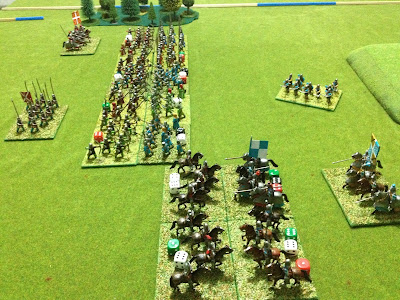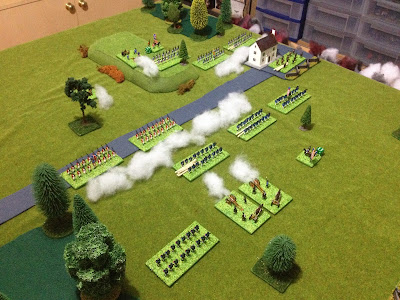British Force
2 light infantry units
2 artillery units
3 line infantry units
3 Hessian line infantry units
1 loyalist militia unit
American Force
2 frontiersmen (skirmish) units
2 artillery units
2 militia units
2 continental line infantry units
Turns 1 and 2
American forces pushed quickly forward into the fields. This was important for the militia who could then take advantage of the field for cover, increasing the number of hits they can absorb before being eliminated. The occupation of the farm buildings and nearby hill boosted the commander resolve from it's starting point of 4 to 6.
The British forces also moved forward to engage the Americans. British commander resolve was boosted from 4 to 5 for the occupation of Rosston Town.
 |
| Opening Moves |
With both sides becoming heavily engaged in and around the fields in the centre. British light infantry moved up on their left flank to harass American forces located on the hill.
 |
| A view from the American herald hill |
In the fight for the fields American forces were holding their own with the support of their artillery. While British artillery were focusing their fire on their American counterparts.
Turns 7 and 8
Casualties were staring to mount and both commanders were busy trying to rally units. In each turn both commanders had units eliminated and their resolve score dipped. British resolve was 3 and American resolve 4.
 |
| British units failed to dislodge American units from the fields |
Turns 9 and 10
The tide of the battle was starting to turn in the American favour. They had seen off the British light infantry and the first line of British units attacking the fields. Their frontiersman were ready on the flank to advance towards Rosston.
 |
| American forces well positioned |
Turns 11 and 12
Both sides had pretty much fought themselves to a standstill in the centre and with some more units eliminated. While American frontiersmen advanced on Rosston and were engaged by the defending forces. Command resolve was reduced to 1 for both sides.
 |
| Add caption |
Turns 13
The final turn saw the loss of a loyalist militia unit defending the town and with that British resolve was zero. So a marginal victory went to the Americans.















































